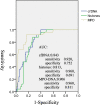Neutrophil extracellular traps predict postoperative pulmonary complications in paediatric patients undergoing parental liver transplantation
- PMID: 37442949
- PMCID: PMC10347742
- DOI: 10.1186/s12876-023-02744-0
Neutrophil extracellular traps predict postoperative pulmonary complications in paediatric patients undergoing parental liver transplantation
Abstract
Background: Parental liver transplantation (PLT) improves long-term survival rates in paediatric hepatic failure patients; however, the mechanism of PLT-induced postoperative pulmonary complications (PPCs) is unclear.
Methods: A total of 133 paediatric patients undergoing PLT were included. Serum levels of NET components, including circulating free DNA (cfDNA), DNA-histone complex, and myeloperoxidase (MPO)-DNA complex, were detected. The occurrence of PPCs post-PLT, prolonged intensive care unit (ICU) stay and death within one year were recorded as the primary and secondary outcomes.
Results: The overall rate of PPCs in the hospital was 47.4%. High levels of serum cfDNA, DNA-histone complexes and MPO-DNA complexes were associated with an increased risk of PPCs (for cfDNA, OR 2.24; for DNA-histone complex, OR 1.64; and for MPO-DNA, OR 1.94), prolonged ICU stay (OR 1.98, 4.26 and 3.69, respectively), and death within one year (OR 1.53, 2.65 and 1.85, respectively). The area under the curve of NET components for the prediction of PPCs was 0.843 for cfDNA, 0.813 for DNA-histone complexes, and 0.906 for MPO-DNA complexes. During the one-year follow-up, the death rate was higher in patients with PPCs than in patients without PPCs (14.3% vs. 2.9%, P = 0.001).
Conclusions: High serum levels of NET components are associated with an increased incidence of PPCs and death within one year in paediatric patients undergoing PLT. Serum levels of NET components serve as a biomarker for post-PLT PPCs and a prognostic indicator.
Keywords: Paediatric; Parental liver transplantation; Postoperative pulmonary complication.
© 2023. The Author(s).
Conflict of interest statement
The authors declare that they have no competing interests.
Figures





References
-
- Bozbas SS, Eyuboglu FO, Ozturk Ergur F, Gullu Arslan N, Sevmis S, Karakayali H, Haberal M. Pulmonary complications and mortality after liver transplant. Exp Clin Transplant. 2008;6(4):264–270. - PubMed
MeSH terms
Substances
Grants and funding
LinkOut - more resources
Full Text Sources
Medical
Research Materials
Miscellaneous

